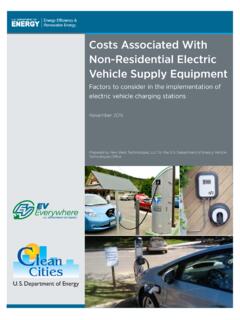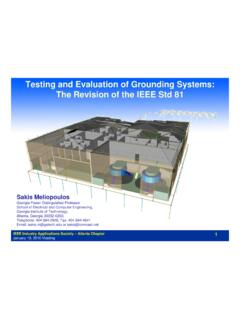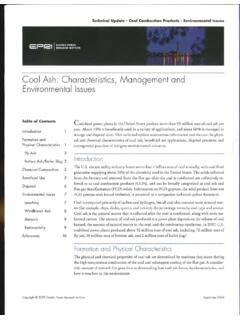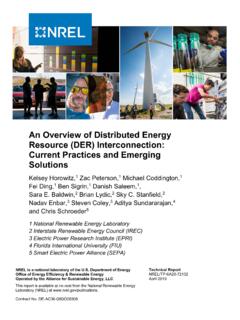Transcription of Guidelines for Estimation of Shear Wave Velocity Profiles
1 PACIFIC EARTHQUAKE ENGINEERING. RESEARCH CENTER. Guidelines for Estimation of Shear Wave Velocity Profiles Bernard R. Wair Jason T. DeJong Department of Civil and Environmental Engineering University of California, Davis Thomas Shantz California Department of Transportation Sacramento PEER 2012/08. DECEMBER 2012. Disclaimer The opinions, findings, and conclusions or recommendations expressed in this publication are those of the author(s) and do not necessarily reflect the views of the study sponsor(s). or the Pacific Earthquake Engineering Research Center. Guidelines for Estimation of Shear Wave Velocity Profiles Bernard R. Wair Jason T. DeJong Department of Civil and Environmental Engineering University of California, Davis Thomas Shantz California Department of Transportation Sacramento PEER Report 2012/08.
2 Pacific Earthquake Engineering Research Center Headquarters at the University of California December 2012. i ii ABSTRACT. Characterization of the small-strain Shear modulus and the Shear wave Velocity of soils and rocks is an integral component of various seismic analyses, including site classification, hazard analysis, site response analysis, and soil structure interaction. The Next Generation Attenuation ground motion prediction equations use the Shear wave Velocity of the top 30 m of the subsurface profile (VS30) as the primary parameter for characterizing the effects of sediment stiffness on ground motions. This report presents Guidelines for estimating the Shear wave Velocity Profiles in the absence of site-specific Shear wave Velocity data.
3 This study consisted of a review of published correlations between Shear wave Velocity and predictor variables, such as, surface geology, standard penetration test N-values, cone penetration test resistance, and undrained Shear strength. This report also presents a method for extrapolation of VS30 for sites where subsurface data does not extend to a depth of 30 m. iii iv ACKNOWLEDGMENTS. This study was sponsored by the Pacific Earthquake Engineering Research Center's (PEER's). Program of Applied Earthquake Engineering Research of Lifelines Systems supported by the California Department of Transportation and the Pacific Gas and Electric Company. Any opinions, findings, conclusions, or recommendations expressed in this material are those of the authors and do not necessarily reflect those of the sponsors.
4 V vi CONTENTS. ABSTRACT .. iii ACKNOWLEDGMENTS ..v TABLE OF CONTENTS .. vii LIST OF FIGURES .. xi LIST OF TABLES .. xiii 1 STUDY OVERVIEW ..1. Site Classification ..3. Next Generation Attenutation Project ..4. VS30 Estimation Methodology ..5. 2 GEOLOGIC CONSIDERATIONS ..7. Rock Properties ..8. Soil Properties ..8. Statistical Correlations between VS30 and Surface Geology ..9. Available Shear Wave Velocity Data ..10. United States Geological Survey Open-File USGS Seismic Cone Penetration Test Database ..12. ROSRINE Boring NGA Flatfile ..12. 3 PENETRATION-BASED VS CORRELATIONS ..13. Overburden Normalization ..13. Evaluation of Correlations ..13. 4 STANDARD PENETRATION TEST CORRELATIONS ..15. Previous Studies.
5 15. Early Studies ..17. Ohta and Goto [1978] ..18. Imai and Tonouchi [1982] ..18. Seed et al. (1983) ..19. Sykora and Stokoe [1983] ..19. vii Seed et al. [1986] ..20. Jinan [1987] ..20. Yoshida et al. [1988] ..20. Lee [1992] ..21. Andrus [1994] ..21. Dickenson [1994] ..21. Lum and Yan [1994] ..22. Rollins et al. [1998]..22. Pitilakis et al. [1999] ..24. Piratheepan [2002] ..25. Hasancebi and Ulusay [2007] ..25. Correlation Equations ..27. All Soils ..27. Clays and Sands ..33. Gravels ..35. Age Scaling Site-Specific Correlations ..38. Recommendations ..40. 5 CONE PENETRATION TEST CORRELATIONS ..41. Soil Behavior Type ..42. Previous Studies ..44. Sykora and Stokoe [1983] ..44. Baldi et al. [1989].
6 46. Hegazy and Mayne [1995] ..47. Mayne and Rix [1995] ..48. Piratheepan [2002] ..49. Mayne [2001] ..51. Andrus et al. [2007] ..51. Robertson [2009] ..51. Correlation Equations ..52. Use of Corrected Tip Resistance in Correlation Equations ..53. Age Scaling viii Selection of Correlation Site-Specific Correlation Equations ..54. Recommendations ..54. 6 UNDRAINED Shear STRENGTH 7. SHALLOW Velocity Profiles AND INTERMEDIATE SITES ..57. Statistical Extrapolation ..57. Intermediate Sites ..59. 8 CONCLUSIONS ..61. Rock Soil Sites ..61. Intermediate Sites ..62. ix x LIST OF FIGURES. Figure Histogram of VS30 and mean +/-1 standard deviation Profiles for fine- grained alluvium [Wills and Calhan 2006]..10. Figure Shear modulus versus SPT N-value [Ohsaki and Iwasaki 1973].
7 17. Figure VS versus SPT N-value [Ohta and Goto 1978]..18. Figure VS versus SPT N-value [Imai and Tonouchi 1982]..19. Figure VS versus SPT N-value [Sykora and Stokoe 1983]..20. Figure VS versus SPT N-value [Dickenson 1994]..22. Figure VS versus SPT N60 [Rollins et al. 1998]..23. Figure VS versus SPT N60 [Pitilakis et al. 1999]..24. Figure VS versus SPT N60 for Holocene Sands [Piratheepan 2002]..25. Figure VS versus SPT N60 for (a) all Soils, (b) sands, and (c) clays [Hasancebi and Ulusay 2007]..26. Figure SPT N60 VS correlation equations for all soils..28. Figure SPT N60 Stress VS Correlation equations for all soils..30. Figure SPT N60 VS correlation equations for clays and silts..31. Figure SPT N60 VS correlation equations for sands.
8 34. Figure SPT N60 Stress VS correlation equations for sands..35. Figure Regression analysis example..39. Figure CPTu schematic [Mayne 2007]..41. Figure SBT chart [Robertson 1990]..43. Figure VS versus qc [Sykora and Stokoe 1983]..45. Figure Estimated VS versus measured VS [Hegazy and Mayne 1995]..47. Figure Predicted versus measured VS for all soils [Piratheepan 2002]..49. Figure VS versus CPT fs [Mayne 2006]..51. Figure VS versus Su [Dickenson 1994]..56. Figure log VS30 versus log VSd for Varying Depths [Boore 2004]..59. xi xii LIST OF TABLES. Table Effect of increase of various factors on Gmax and VS.* ..2. Table Comparison of various in situ VS measurement methods..3. Table Caltrans/NEHRP soil profile types.
9 4. Table Effect of increase of rock properties on VS..8. Table Shear wave Velocity characteristics of geologic units in California from Wills and Clahan [2006]..9. Table Summary of USGS Open-File Reports..11. Table Studies between the Standard Penetration Test and VS..16. Table PT VS correlation equations for all soils: Equations ( ) through ( )..28. Table SPT Stress VS correlation equations for all Soils: Equations ( ) through ( )..29. Table SPT VS correlation equations for clays and silts: Equations ( ) through ( )..31. Table SPT Stress VS correlation equations for clays and silts: Equations ( ). through ( )..32. Table SPT VS correlation equations for sands: Equations ( ) through ( )..33. Table SPT Stress VS correlation equations for sands: Equations ( ) through ( ).
10 34. Table SPT VS correlation equations for gravels: Equations ( ) through ( )..36. Table SPT stress VS Correlation equations for gravels: Equations ( ) through ( )..37. Table Age scaling factors for SPT VS correlation equations..38. Table Recommended SPT stress VS correlation equations..40. Table CPT soil behavior types..43. Table Studies between the Cone Penetration Test and Table CPT VS Correlation equations: Equations ( ) through ( )..52. Table Boore [2004] regression coefficients..58. xiii xiv 1 Study Overview Characterization of the stress-strain behavior of soils is an integral component of many seismic analyses, including site classification, hazard analysis, site response analysis, and soil structure interaction.








